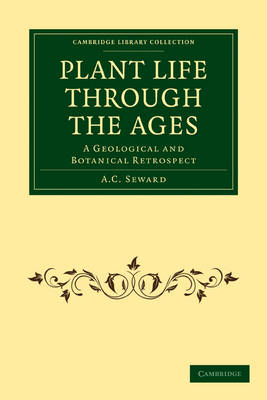Cambridge Library Collection - Earth Science
2 primary works • 6 total works
Volume 1
A. C. Seward (1863–1941) was an eminent English geologist and botanist who pioneered the study of palaeobotany. After graduating from St John's College, Cambridge, in 1886 Seward was appointed a University Lecturer in Botany in 1890. In 1898 he was elected a Fellow of the Royal Society, and was appointed Professor of Botany in 1906. These volumes, published to great acclaim between 1898 and 1919, provide a detailed discussion and study of an emerging science. In the early nineteenth century, research and critical literature concerning palaeobotany was scattered across disciplines. In these volumes Seward synthesised and revised this research and also included a substantial amount of new material. Furnished with concise descriptions of fossil plants, detailed figures and extensive bibliographies these volumes became the standard reference for palaeobotany well into the twentieth century. Volume 1, published in 1898, contains an overview of palaeobotany with systematic descriptions of fossil plants.
Volume 2
A. C. Seward (1863–1941) was an eminent English geologist and botanist who pioneered the study of palaeobotany. After graduating from St John's College, Cambridge, in 1886 Seward was appointed a University Lecturer in Botany in 1890. In 1898 he was elected a Fellow of the Royal Society, and was appointed Professor of Botany in 1906. These volumes, published to great acclaim between 1898 and 1919, provide a detailed discussion and study of an emerging science. In the early nineteenth century, research and critical literature concerning palaeobotany was scattered across disciplines. In these volumes Seward synthesised and revised this research and also included a substantial amount of new material. Furnished with concise descriptions of fossil plants, detailed figures and extensive bibliographies these volumes became the standard reference for palaeobotany well into the twentieth century. Volume 2, first published in 1910, contains systematic descriptions of fossil ferns.
Published in 1931 to complement Seward's magisterial four-volume textbook Fossil Plants, this book is a digest of his earlier detailed study, written for a non-specialist audience as an introduction to the field of palaeobotany. Seward begins by describing the basics of geology and palaeobotany in order to explain how the interpretation of fossilised plant remains found in rocks can shed light on the natural world of prehistoric times. He then covers geological periods in chronological sequence, from the Pre-Cambrian to the Quaternary. Throughout, he emphasises the fragmentary nature of the evidence and the difficulties in extrapolating from the surviving fossil record, but he also explains the great discoveries made in the field and how they came about. The accompanying drawings give an impression of the likely combinations of plants found in each period, allowing the reader to visualise the different landscapes evoked in Seward's engaging prose.
A. C. Seward (1863-1941) was an eminent English geologist and botanist who pioneered the study of palaeobotany. After graduating from St John's College, Cambridge, in 1886 Seward was appointed a University Lecturer in Botany in 1890. In 1898 he was elected a Fellow of the Royal Society, and was appointed Professor of Botany in 1906. These volumes, published to great acclaim between 1898 and 1919, provide a detailed discussion and study of an emerging science. In the early nineteenth century, research and critical literature concerning palaeobotany was scattered across disciplines. In these volumes Seward synthesised and revised this research and also included a substantial amount of new material. Furnished with concise descriptions of fossil plants, detailed figures and extensive bibliographies these volumes became the standard reference for palaeobotany well into the twentieth century.
A. C. Seward (1863–1941) was an eminent English geologist and botanist who pioneered the study of palaeobotany. After graduating from St John's College, Cambridge, in 1886 Seward was appointed a University Lecturer in Botany in 1890. In 1898 he was elected a Fellow of the Royal Society, and was appointed Professor of Botany in 1906. These volumes, published to great acclaim between 1898 and 1919, provide a detailed discussion and study of an emerging science. In the early nineteenth century, research and critical literature concerning palaeobotany was scattered across disciplines. In these volumes Seward synthesised and revised this research and also included a substantial amount of new material. Furnished with concise descriptions of fossil plants, detailed figures and extensive bibliographies these volumes became the standard reference for palaeobotany well into the twentieth century. Volume 4, first published in 1919, contains systematic descriptions of fossil ginkgoales and coniferales.
A. C. Seward (1863–1941) was an eminent English geologist and botanist who pioneered the study of palaeobotany. After graduating from St John's College, Cambridge, in 1886 Seward was appointed a University Lecturer in Botany in 1890. In 1898 he was elected a Fellow of the Royal Society, and was appointed Professor of Botany in 1906. These volumes, published to great acclaim between 1898 and 1919, provide a detailed discussion and study of an emerging science. In the early nineteenth century, research and critical literature concerning palaeobotany was scattered across disciplines. In these volumes Seward synthesised and revised this research and also included a substantial amount of new material. Furnished with concise descriptions of fossil plants, detailed figures and extensive bibliographies these volumes became the standard reference for palaeobotany well into the twentieth century. Volume 3, first published in 1917, contains systematic descriptions of fossil seed plants.


